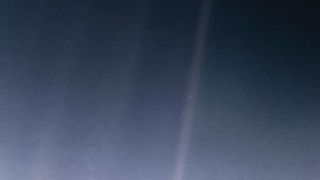Voyager 1 Trajectory through the Solar System
This visualization tracks the trajectory of the Voyager 1 spacecraft through the solar system. Launched on September 5, 1977, it was one of two spacecraft sent to visit the giant planets of the outer solar system. Voyager 1 flew by Jupiter and Saturn before being directed out of the solar system.
To fit the 40 year history of the mission into a short visualization, the pacing of time accelerates through most of the movie, starting at about 5 days per second at the beginning and speeding up to about 11 months per second after the planet flybys are past.
The termination shock and heliopause are the 'boundaries' created when the plasma between the stars interacts with the plasma flowing outward from the Sun. They are represented with simple grid models and oriented so their 'nose' is pointed in the direction (Right Ascension = 17h 24m, declination = 17 degrees south) represented by more recent measurements from other missions.
Visualization centered on the Voyager 1 trajectory through the solar system.
Voyager 1's 'Family Portrait' On Valentine's Day 1990, Voyager 1's camera were pointed back at the solar system to image the planets.
Check out Voyager at NASA/JPL for more information.

Opening view of Earth orbit looking outward to the rest of the solar system.

Voyager 1 (and 2) cross the orbit of Mars, slightly above the ecliptic plane to avoid the asteroid belt between Mars & Jupiter.

The camera moves out ahead of the Voyagers for a view back at the inner solar system.

Voyager 1 just after the Jupiter flyby on March 5, 1979.

Voyager 1 just before the Saturn flyby on November 12, 1980.

With a gravity-assist from the Saturn flyby, Voyager 1 is directed above the plane of the solar system and continues outward. This is near the time of the Voyager 1 'Family Portrait'. The orbit of Pluto is the grey orbit visible above the orbits of the other planets.

Voyager 1 crosses the termination shock of the solar wind. For simplified and symmetric termination shock model, the timing is not accurate. In reality, this crossing occurred around December of 2004.

Voyager 1 (and 2) beyond the heliopause near the end of 2017.
A slightly sped-up version of the Voyager 1 visualization above, reducing the time for the Voyagers to cross the asteroid belt.
Credits
Please give credit for this item to:
NASA's Scientific Visualization Studio
-
Animator
- Tom Bridgman (Global Science and Technology, Inc.)
-
Writer
- Kathalina Tran (KBR Wyle Services, LLC)
-
Producers
- Genna Duberstein (USRA)
- Scott Wiessinger (USRA)
-
Project support
- Laurence Schuler (ADNET Systems, Inc.)
- Ian Jones (ADNET Systems, Inc.)
Release date
This page was originally published on Thursday, August 31, 2017.
This page was last updated on Sunday, February 2, 2025 at 10:13 PM EST.
Missions
This page is related to the following missions:Series
This page can be found in the following series:Datasets used
-
DE 431
ID: 985Planetary ephemerides SPICE kernel
See all pages that use this dataset
Note: While we identify the data sets used on this page, we do not store any further details, nor the data sets themselves on our site.



